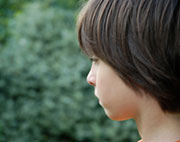
WEDNESDAY, July 31 (HealthDay News) — Children with autism exhibit unusual brain chemistry that can change over time, new research shows.
That particular chemistry differs from both children with other developmental delays and children with typical development, the University of Washington researchers noted, and it adds to a growing body of evidence that suggests early interventions can alter outcomes in kids with autism.
The findings support the notion that autism spectrum disorder is fundamentally different from other developmental disorders, said study author Stephen Dager, associate director of the university’s Center on Human Development and Disability.
“Children with autism showed a very different developmental course than kids who had developmental delays without autism,” Dager said. “We’re hoping to better understand what the processes are so we can develop more focused interventions that can help to modify these processes to the benefit of the individual.”
The discovery also emphasizes the positive impact that early intervention can have on children with autism, said autism expert Dr. Ali Carine, an osteopathic pediatrician in Columbus, Ohio.
“Autism stands as a different type of process than a stagnant developmental process,” Carine said. “We need to identify autistic children and start intervention when the potential for change is greatest. Clinically, we know the younger we catch these kids, the more they respond to intervention.”
One of the researchers put it this way:
“A substantial number of kids with early, severe autism symptoms make tremendous improvements,” said study co-author Annette Estes, director of the University of Washington’s Autism Center. “We’re only measuring part of the iceberg, but this is a glimmer that we might be able to find a more specific period of vulnerability that we can measure and learn how to do something more proactively.”
Experts estimate that by age 8, one out of every 88 children will develop some form of autism, according to the U.S. Centers for Disease Control and Prevention. Boys are four times more likely than girls to have an autism spectrum disorder.
In the study, researchers used MRI scans to measure the tissue-based brain chemicals of children at 3 to 4 years, 6 to 7 years and 9 to 10 years. They measured kids who had been diagnosed with autism, kids diagnosed with developmental delays and kids with typical development.
The investigators found particularly interesting changes in N-acetylaspartate (NAA), a chemical thought to play an important role in the development and regulation of synaptic connections in the brain. NAA levels are lower in people with conditions such as Alzheimer’s, traumatic brain injury or stroke.
The researchers found that at ages 3 to 4, children in the autism and developmental delay groups had low NAA concentrations in the gray matter of their brains. However, by ages 9 to 10, children with autism had NAA levels that had caught up to those exhibited by typically developing kids, while NAA remained low in the developmentally delayed group.
The results were reported online July 31 in JAMA Psychiatry.
While these findings are illuminating, they do not pinpoint when autism is likely to develop in children or why it happens, Dager said.
Future research will likely need to investigate children as young as 1 to 2 years old to capture the first brain chemistry changes that lead to autism, Carine said.
“They really believe, based on other published data, that they didn’t capture the most dynamic period of children’s brain development,” Carine said of the new study. “Age 1 to 2 years old is the time when parents of autistic kids say their children seemed to stall, or they had speech and lost it.”
Dager and other researchers at the University of Washington are currently using more advanced MRI methods to study infants considered at risk for autism because they have an older sibling with the disorder.
“We’re looking prospectively at these children, starting at 6 months, to determine if we can detect very early alterations in brain cell signaling or related cellular disruption that may precede early, subtle clinical symptoms of autism spectrum disorder,” Dager said.
More information
For more information on autism, visit the U.S. National Institutes of Health.
Copyright © 2025 HealthDay. All rights reserved.

